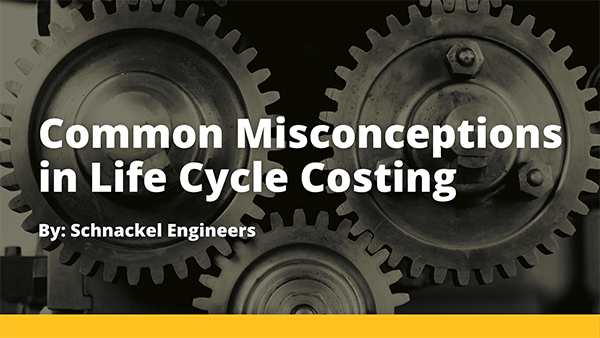Common Misconceptions in Life Cycle Costing

Life cycle costing is a time-sensitive and data-driven method of economic analysis that is used to calculate the total costs of a construction project over an extended timeframe. It takes into account the costs associated with the acquiring, operation and maintenance of a project.
Several different factors affect the life cycle costing of a project, including its initial purchase, maintenance costs, energy consumption expenses, replacement costs, and more.
While one can’t deny the significance of using life cycle costing for construction projects, several misconceptions are related to it. In this blog post, we will shed light on life cycle costing and uncover some common myths associated with it.
What is Life Cycle Costing?
As mentioned above, the process of economic analysis to assess the life cycle of a project is known as life cycle costing. This method helps you identify a project’s major cost drivers and determine its long-term viability and potential for financial success (or failure).
Through life cycle costing, businesses can plan for the future by anticipating how much it would cost to run an asset / investment during its lifetime, starting from when it is first purchased until its disposal.
This method is widely used because of its ability to create a long-term balance between risks, costs, and performance that many other methods do not offer. It can help you achieve tangible goals, such as profit-maximization or reducing working capital needs over time. As a quantitative analysis, life cycle costing also helps companies identify opportunities related to sustainability efforts that may not have been considered beforehand.
Common Misconceptions in Building Life Cycle Costing (LCC)
LCC Only Looks at Energy Costs
Life cycle cost analysis is a valuable tool that can help you make informed, well-thought-out decisions about your business. After all, it considers all costs, including short and long-term, as well as budget overruns or maintenance fees. It is not the same as energy cost modeling. In fact, it goes much deeper into the economic costs of owning and operating systems over the life of the facility.
It can help you explore what might work best for your business based on various factors that may affect your business. For example, these factors may include a new technology coming out in the market, marketability of your project, costs of operating engineers or other specialized labor required to operate and maintain your equipment, and so on. All of this can be unpredictable or unanticipated and costly nonetheless.
LCC Overlooks Environmental Costs
Life cycle costing has been criticized for overlooking the environmental impacts of construction projects. Eco-friendly materials are expensive, which means companies can end up with higher total life cycle costs by using them.
However, thanks to technological advancements, construction project managers are now utilizing more cost-effective, eco-friendly materials that can be included from a life cycle cost perspective. It’s also worth noting that modern equipment like HVAC systems are more energy-efficient than their traditional counterparts. Traditional HVAC systems consume higher amounts of energy over their entire lifespan, which makes it clear which one out of the available options will give you cost-saving benefits in the long run.
There are many ways to save money, and adopting green products is undoubtedly one of them. However, construction project managers must realize some initial costs may come with transitioning to eco-friendly materials before they can start saving more than what they’re spending now. But once those upfront investments have been made, they’ll end up paying off over time.
The life cycle costing method allows contracting authorities to understand and select the most economical products for projects over time, including not just the initial purchase price but the usage costs, maintenance, and the resale value of your investment.
For example, an environmentally friendly building can save money in the long term. The upfront costs of such a project may be higher than other projects. Still, over time, it will pay off in terms of reductions in utility bills.
In fact, if you’re looking for a way to improve your project’s green credentials, LCC is the perfect option. Not only does it make earning points easier and tracking simpler, but many organizations incorporate LCC credits into their certifications schemes.
LCC Can Be Implemented at the Later Stages of a Project
It is always advisable to implement LCC at the earliest stage in a construction project so you can identify alternatives before making any significant decisions. Waiting or thinking and implementing it after making your initial decision will be costly.
The LCC process should be performed in parallel with the earliest design stages. Double-checking your calculations as you go about the project is critical to stay on budget and ensure quality control. Thus, it’s essential not to neglect this step of the overall project management process.
Conclusion
The life cycle costing method is a powerful tool that can be used to evaluate the economic viability of projects over time. It considers not just purchase price, but also maintenance costs and other factors like usage cost, replacement cost and resale value when determining what product will generate the most savings for your business.
Understanding life cycle costing is essential for construction project managers, architects and owners because it can help them make better asset management decisions. These decisions can allow them to save money in the long run and reduce depreciation expenses on assets.
If you want help selecting the most cost-efficient solutions for your construction projects, contact us now.
Comments